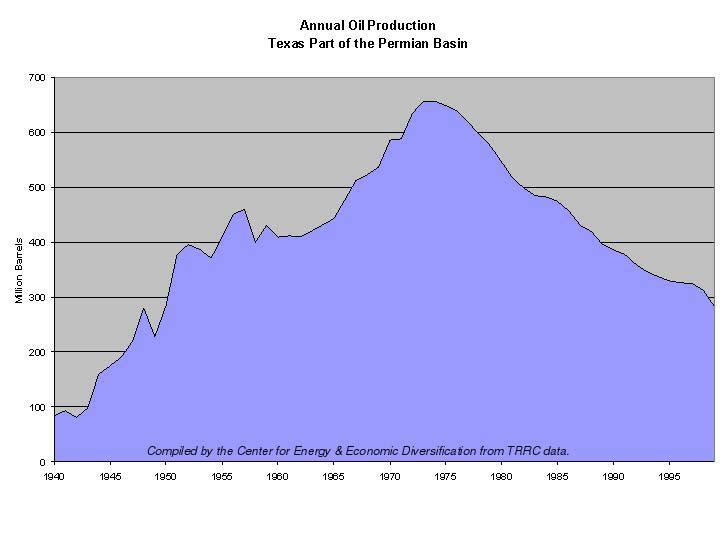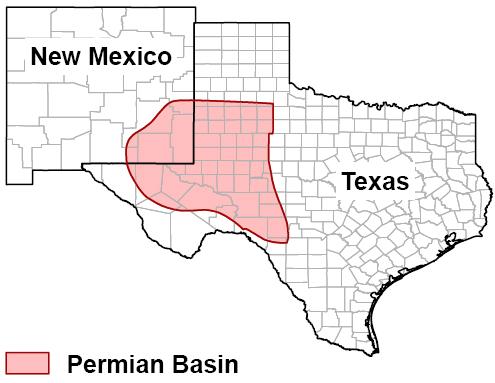
At around 6 o’clock on the morning of May 28, 1923, an oil well named after the patron saint of the impossible blew.
The well sprayed oil over the top of the derrick and covered a 250-yard area around the site…
This is an actual picture of it:

On that morning, the Permian oil boom in Texas was born.
The name of the well was Santa Rita No. 1.
According to official state records in Texas, between 1917 and 1919, more than 5,000 drilling permits were issued for the Permian Basin. However, no exploration occurred… until August 23, 1921, when — just four hours before its permit was set to expire — the Santa Rita No. 1 was spudded.
Drilling continued for almost two years at the drill site before they struck the gusher.
For the next 50 years, the legendary Permian Basin dominated the world.
It has pumped out 35 billion barrels since Santa Rita No. 1 started spewing.
The field peaked in production between 1973 and 1974, as predicted by Shell geologist M. King Hubbert.

At its height, the Permian was pumping out over 1.7 million barrels per day.
When the Permian peaked, it marked the end of American oil domination and ushered in OPEC. And for the next 40 years, OPEC would have a stranglehold on the world’s energy economy.

But that was that was four decades ago.
A lot of things have changed — and quite dramatically…
Thanks to the revolution in hydraulic fracturing, the Permian is expected to regain its stature in the global oil market. It is set to become the king.
Oil and gas companies are rushing into West Texas like army ants. And it’s easy to see why.
“That would be the equivalent of 10 Eagle Ford shales stacked on top of each other. It’s 17 Bakkens placed on top of one another.”
That’s how a new American shale play is being described. That’s how big it is.
The industry-respected, Houston-based Hart Energy Magazine says: “There’s just oil all over the place,” and estimates the field could produce more than 1.65 million barrels of oil per day within seven years.
At that daily production, this single oilfield would produce nearly four times more oil than OPEC member Ecuador. It would represent 66% of all of Mexico’s oil production (at its current rate)!
It’s a modern-day black gold rush. And it’s the hottest play in America — hotter than California’s Monterey… hotter than Texas’ Eagle Ford… and even hotter than North Dakota’s booming Bakken.
In fact, as you read this, the field I’m talking about has over 400 drill rigs currently operating in it. To give you an idea of how much that is, it accounts for 10% of all drilling rigs currently in operation on the planet.
I’m talking about the revived Permian Basin in Texas — and the Cline Shale that lies within it.
If you haven’t heard of the Cline Shale, it is a monster: Lying roughly 1.8 miles below the surface of the Permian, the Cline runs about 140 miles from north to south and 70 miles wide. So it’s approximately 9,800 square miles in size.
Devon Energy was one of the first companies in the Cline Shale. A recent study from Devon estimated the Cline Shale contains 3.6 million barrels of recoverable oil per square mile.
Let’s do the math on that one: 9,800 sq. miles x 3,600,000 = 35 billion barrels of oil.
That’s a gross resource value of $3 trillion at today’s WTI price of $91 per barrel.
It’s a resource treasure for the United States, plain and simple. With Devon’s estimate of 3.6 million barrels per square mile, it exceeds the Bakken and Eagle Ford by nearly 50%.
The Eagle Ford pay zone is 20 to 35 feet thick; the Bakken is 10 to 25 feet thick… but the Cline is estimated to be anywhere from 200 to 550 feet thick. It’s enormous.
And the Cline resides inside the legendary, prolific Permian Basin, which to date has pumped out some 35 billion barrels of oil from multiple pay zones.
Drillers are going back for the oil that’s been left behind.
And they’re finding more and more formations within the Permian…
That’s why the play is the hottest in the world right now.
With the price of oil spurring activity, the Permian rig count has increased nearly 339% since April 2009, from 92 to 404 at the end of January.
Get ready to make money off of this play. It’s going to go great guns for decades.
Forever wealth,
![]()
Brian Hicks
Brian is a founding member and President of Angel Publishing and investment director for the income and dividend newsletter The Wealth Advisory. He writes about general investment strategies for Wealth Daily, Energy & Capital, and the H & L Market Report. Known as the “original bull on America,” Brian is also the author of Profit from the Peak: The End of Oil and the Greatest Investment Event of the Century, published in 2008. In addition to writing about the economy, investments and politics, Brian is also a frequent guest on CNBC, Bloomberg, Fox, and countless radio shows. For more on Brian, take a look at his editor’s page.












